How the climate is changing the taste of beer

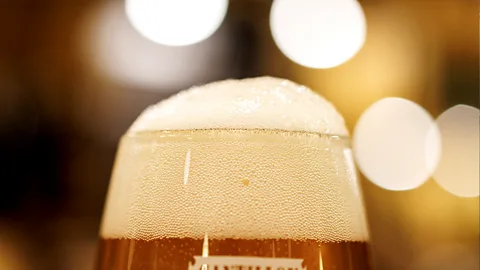 Getty Images
Getty ImagesWith a fresh fizz and hoppy scent, a cold beer is a drink that touches all of our senses. But as our climate changes, so too might the flavour profile of one of the world's most popular drinks.
With its satisfying, tantalising flavour, few drinks evoke as familiar a feeling as a freshly poured beer. "It's not only bitter, it's not only sweet, it almost invites you to a next sip, and that's a very difficult quality to describe," says Mirek Trnka, a researcher at the Global Change Research Institute Academy of Sciences of the Czech Republic.
The flavour of beer is created by a complex symphony of chemical compounds from three ingredients; hops, yeast and malted barley. But now climate change is threatening the production of two of those – barley and hops. Trnka and his colleagues say that the traditional crops that brewers rely on to create beer – called noble hops – will become "more difficult to grow".
Trnka’s research shows that production of noble hops has decreased by 20% since the 1970s in some of Europe's biggest hop-growing regions. Alpha acids are the key compound in noble hops that give beer its distinctive bitter flavour and Trnka's study concludes that levels of alpha acids will decrease by 31% by 2050. Is beer facing an existential crisis? Can anything be done to secure its flavour in the future?
Beer, one of the world's favourite drinks, and the most popular alcoholic beverage by volume, has been a part of society since humanity discovered agriculture. Evidence of grain-based fermented alcoholic drinks has been found as far and wide as Jiahu, a Neolithic site in China dating to at least 5700 BC, and prehispanic Andean societies, such as the Moche culture from the Second to the Eighth Century AD. In the Near East, Mesopotamian cuneiform texts and seals depict beer being drunk. In fact, there is evidence of beer being made on every continent in the ancient world.
Whether it was corn, rice or cereal, early farmers learnt that fermenting grain could produce a drink with intoxicating effects. It was as much a social lubricant for people in the ancient world as it is in pubs and bars the world over today.
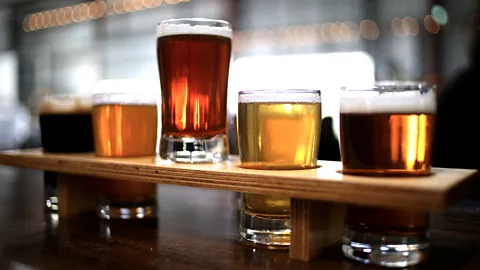 Getty Images
Getty ImagesInitially, hops were added as a preservative, not a flavouring. "It was discovered during medieval ages that hops added an antimicrobial benefit to the beer, preventing the beer from spoiling in a manner that would make it sour – so it added shelf life," says Thomas Shellhammer, a professor of fermentation science at Oregon State University.
How is beer made?
Beer is traditionally made from four ingredients: water, malted barley, yeast and hops.
Barley kernels are soaked in water to soften the husk and start the germination process. They are then drained and dried in a kiln to halt germination. As they begin to sprout, the enzyme amylase converts the starch stored in the kernel into sugars. These are important for the flavour of the beer, and as a food source for yeast, which later will ferment the beer to make alcohol.
Once dried, they are roasted in a kiln. The longer and hotter the roast, the darker the final colour and the richer and more toasted the final flavour.
Next, the malted barley is milled and mashed with hot water to release the sugars. The mixture is then boiled with dried hops, and cooled to around 20C (68F) for ales and 12C (54F) for lagers. Once cool, yeast is added. The fermentation stage usually takes several weeks, before the beer is filtered and bottled.
Before the Industrial Revolution and the introduction of kilns and stainless steel vats, hops would have been dried over fires which would also have imparted a strong smokey flavour to the beer, says Shellhammer. It was only possible to develop light, hoppy lagers after the Industrial Revolution and the widespread use of steel. Malt has a sweet aroma and flavour, so hops are key to balance out this sweetness with bitter flavours from hops. "The aromatic flavour of hops became as important as other elements, rather than just being functional to the process of making beer."
These early beers would have been weaker in alcohol and highly variable in flavour. In early beer making, a "universe of herbs and spices" other than hops would have been used as alternative flavourings and preservatives, including heather flowers, spruce tips, sage, rosemary and juniper.
The antimicrobial properties are created by some compounds in the hops called alpha acids and beta acids, which are also the source of beer's bitter taste. "During the boiling stage, the alpha acids isomerise [change shape] into another compound, and that chemical reconfiguration makes them more bitter," says Shellhammer. Very bitter beers, like Indian pale ales (IPAs) are made with hops with a high alpha-acid content to really accentuate those bitter flavours.
The popularity of hops really took off after the Industrial Revolution, says Trnka, because the flavour profile shone through in clearer, lighter beers. The consistency with which brewers could make tasty beers with hops pushed this crop ahead of other flavorings in popularity.
Nowhere did lighter beers take off more than in Central Europe – particularly in the regions that are now in Czechia, Slovakia and Germany – where lager was invented. The hops grown here, called noble hops, have become highly esteemed for giving lagers their distinctive flavour. "This is a relatively traditional industry," says Trnka. "You get a premium if you grow these noble hops, these old cultivars, especially in Czechia where it is part of 100 years of tradition."
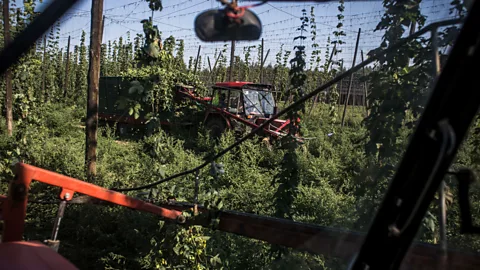 Getty Images
Getty ImagesTrnka and his colleagues' climate research focused on noble hop varieties. Rising temperatures caused by climate change have moved the start of the noble hop growing season in Germany and Czechia by 13 days between 1970 and 2018, and ripening has moved 20 days earlier. Trnka's projections suggest that by 2050 noble hop yields will decline between 4.1 and 18.4% when compared to 1989-2018, along with a similar drop in the alpha acid content, due to rising temperatures and more frequent droughts.
While some effects of higher temperatures and droughts can be overcome with irrigation, says Shellhammer, at very high temperatures of around 46C (116F) plants stop growing, and some diseases thrive in hotter temperatures.
"But, if you want to grow the same hops as our forefathers grew from 19th Century, or even before, these noble hops that are very prized for the light lagers that Czechia is so famous for, there are ways to adapt," says Trnka.
Hop farmers have a few options: relocating hops to areas with higher water tables, for example in valleys or by streams, where water is more easily taken up by plant roots, adding drip irrigation or switching to more climate-resistant varieties. These have all proven successful strategies in wine-making, where viticulture is also threatened by climate change.
In some ways, says Shellhammer, beer makers are luckier than vintners, who are solely reliant on one ingredient – grapes – while they can adjust yeast, malt and hops to perfect a flavour.
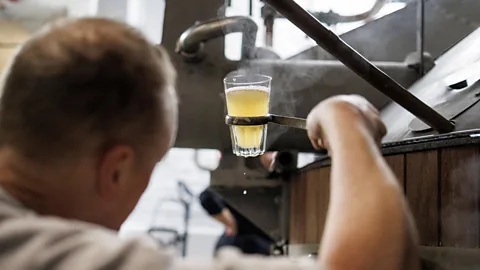 Getty Images
Getty ImagesBut not all of these solutions will be easy to implement, warns Chuck Skypeck, technical brewing projects director at the Brewers' Association in the US. Irrigation is more common in North America than it is in Europe, and is costly to introduce, says Skypeck. Switching varieties is also easier said than done. Hops are perennial crops, meaning the plant remains in the soil every year. Like other perennial crops, such as tea, coffee or grapes, changing cultivar would require digging up the entire plant, he says. Changing grain cultivars is much easier as each year new crops are sown from seed.
But Shellhammer thinks that switching hop varieties might only result in a couple of years of reduced yield. "In the Northwest United States, I've spoken to growers that say they could switch out a crop and get close to 75% of the yield in the first year," he says. "With wine grapes, you're waiting for a whole grapevine to grow and produce – so it's a multi-year endeavour."
Skypeck adds that breeding programmes in place in North America and all the major hop-growing regions are focused on new varieties for changing flavours and aromas, and finding varieties that are adapted better to changing climatic conditions. Those adaptations include deeper, denser root structures that are more drought resistant. These new varieties are proving popular with artisan brewers and brewers of bitters and ales. "It's driven a lot of the craft and independent beer movement in the US," he says.
New hop varieties are being bred to be more resistant to the changing climate, says Skypeck, but to develop a new hop variety from scratch to full production can take up to 10 years. For example, a new experimental variety may show more heat resistance but might still require a similar amount of water, he says. "Brewers take different approaches as well. US craft brewers rarely only use one variety of hops in their beers, rather layering different flavours and aromas to create the different character you find in many craft beers. On the other hand, more conservative traditional German brewers can be reluctant to adopt new varieties because they don't want to change the character of their beers that has been consistent for years."
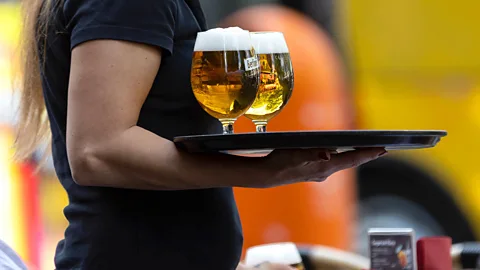 Getty Images
Getty ImagesChristian Ettinger, founder of Hopworks Urban Brewery in Portland, US, says that one of their typical beers might contain between two and five different varieties of hops, which gives the brewer scope to adjust the recipe to account for changes in yields. "Selecting hops and forecasting is difficult, and it requires you to go spreadsheet by spreadsheet, tune your recipes, look at your overall volumes," he says.
Water scarcity is one major contributor to low yields in the US, which drives the cost of hops up, says Ettinger. "Beer has been the most popular alcohol beverage for 9,000 years, and part of that is it's accessibility and affordability. It's incumbent upon us as cultivators to make sure it's still accessible."
Ettinger has been brewing beer for 30 years and in that time has seen how the industry has adjusted to climate change by introducing regenerative agricultural techniques like cover cropping – which involves growing other crops between the hop plants to suppress weeds, reduce erosion and improve soil health – and biochar – which is the addition of carbon-rich, organic material that improves water retention in the soil. "The beautiful part about sustainability is you're trying to minimise your footprint, because it is better for the planet, and it is less expensive – it makes you more efficient and economically competitive."
A recent trend in the US is for "fresh hop beers" which are produced with hops that celebrate the uniqueness of that year's harvest, says Skypeck. "There's consumers that are interested in experimentation and variety."
Whether consumers embrace a more varied palette of beers or stick to familiar lagers, "it's not going to be the end of the world," says Trnka. "We will still be able to make beer."
--
For essential climate news and hopeful developments to your inbox, sign up to the Future Earth newsletter, while The Essential List delivers a handpicked selection of features and insights twice a week.
For more science, technology, environment and health stories from the BBC, follow us on Facebook, X and Instagram.
